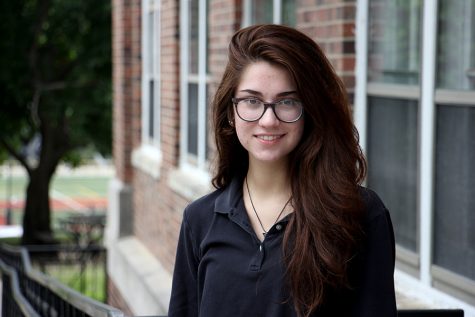Small classes at STA have a huge impact
Smaller classes offer opportunities for a more intimate learning experience, creating an environment that encourages discussion and asking questions.

Theater teacher Shana Prentiss shows the students of her Technical Theater and Lighting class a stage design computer program, helpful for the devising and executing of prop and actor placement. photo by Cassie Hayes
November 17, 2016
story by Gwyn Doran
The handful of students leaning back in their chairs and casually chatting with each other about the weekend could be mistaken for a free period. When the bell rings, their instructor gives an overview of the lesson plan, allowing time for questions and small talk. At STA, such is the story of the small class size community. With a handful of classes with under ten students enrolled, students in these classes experience a new aspect of the STA community.
Senior Mary LePique’s College Latin IV class consists of six students who are in their fourth and final year of the Latin program together. LePique’s freshman Latin I class, with an enrollment of 14 girls, dropped down to the current six: seniors Emma Kate Callahan, Marin Brown, Molly Muehlebach, Jeannie O’Flaherty, Emma Swinney and LePique.
For LePique, Latin has been a fundamental part of her STA experience, and the small size plays a huge role.
“I’ve grown really close to all of the girls in my class,” LePique said. “It makes it more conducive to learning…There is an unspoken language between all of the people in my class and myself.”
LePique also cites Latin teacher Sue Marquis as contributing to her love of Latin class.
“I remember the very first test that I took,” LePique said. “I got a low score on it, and she was determined to help and make sure that I was able to be on the same page as everyone else. She’s more approachable for issues outside of the classroom as well. I went on a trip with her this past summer and I was really able to talk to her, not only as my teacher, but also as a motherly figure. She’s always had that kind of role in my life.”
This past spring, the College Latin IV class nearly disappeared from the curriculum. LePique says the six students intending to take the class for the 2016-2017 school year protested, eventually resulting in the reinstatement of the class.
“It was incredibly empowering,” LePique said. “We actually told the [Rockhurst University] Classics teacher the story, and he said that’s what admissions counselors want to read about – seeing passionate students striving to make a difference,” LePique said. “[Marquis] is a true educator. I think there’s a difference between just being a teacher, and actually instilling that love for learning in your students.”
Latin isn’t the only language community on campus with such tight bonds – senior Tori Cartee’s Chinese class of three people has been consistent since her freshman year. But with a smaller class size come potential struggles with teaching. Cartee cites the journey through multiple teachers for the same subject as a bonding element for the students enrolled in Chinese.
“I have taken Chinese with these girls for 4 years,” Cartee said. “In those four years, we have bonded over how much of a struggle Chinese is and have become best friends. We have experienced so many different types of teachings and teachers over the years in Chinese and learned how to work with different types of teachers.”
In addition to adjusting to new teachers with a close-knit group of girls, Cartee finds having a smaller class size contributes to her comfort in and enjoyment of the subject itself.
“I think that it is easier to speak up or ask questions in my class because there are fewer people and less anxiety of sounding stupid because you do grow to close with your smaller class,” Cartee said. “I think I bond more with my Chinese class even before I became best friends with [seniors] Lauren McCann and Kamryn Lanier because of the size. I stuck with it because of the bond I made with my freshman class.”
Because the small class size lends itself to a variety of instructional techniques, STA, in preparation for the 2015-2016 school year, chose to transition the Chinese class from a traditional classroom setting to a Skype-based learning environment. Currently, the Chinese programs use Skype to communicate with a teacher at the University of Kansas’ Confucius Institute. Despite some technological setbacks, including scheduling miscommunications and technological malfunctions, Cartee and her classmates still manage to tackle the language.
“At the beginning, it was a struggle learning how to run all of the equipment that we use everyday and learning how to fix the technical difficulties by ourselves,” Cartee said. “It is also sometimes hectic because she might not know what [particular schedule changes are happening on the STA campus] and has once even called for class while a freshman seminar was going on.”
For Cartee, however, the positives of her Chinese experience – her friends, her growth, her understanding of Chinese – outweigh the technological setbacks.
Across campus, before her senior year, senior Michaela Coleman opted out of the traditional math circuit in favor of the lesser known College Stats and Probability course. Coleman’s decision is based on a possible career path of environmental studies and public health.
“I’ve been considering environmental studies and public health for a study/career path,” Coleman said. “Statistics and probabilities are concepts that will genuinely be more applicable to and useful for my intended studies than, say, AP Calculus.”
Although Coleman hasn’t gone through all four years of high school with the same math class, like the Chinese and Latin classes have, Coleman finds community in the class structure itself, which she believes fosters closer relationships between students and with the teacher.
“It feels like discussion even if it’s lecture,” Coleman said. “It feels as though she shares it with us as opposed to bombarding us with heavy loads of information to scribble down, and as though we are all involved. When some of us aren’t involved, because we might not have finished homework, or because we might be tired that day, it offsets the flow of the class. Days in which all four of us seniors are not attentive and involved feel long, drawn out, and forced. ”
While communities in math and language bond in a classroom environment, sophomore Jillian Morrison is a bit more hands on in Technical Theater, a four-person class that programs lights for the musical, including the backstage work like changing burnt out light bulbs.
Morrison describes the small class experience best when she says, “Going to this class and spending time with my friends lights up my day.”




